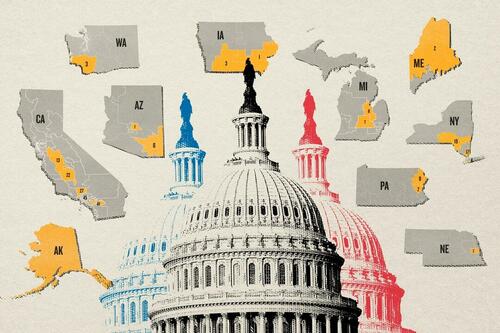Authored by Joseph Lord, Stacy Robinson via The Epoch Times (emphasis ours),
While most national attention is on the top-of-the-ticket race between former President Donald Trump and Vice President Kamala Harris, control of Congress will be equally consequential.
Republicans currently hold a narrow majority of eight seats in the House, meaning they can only spare three defections on big votes. Democrats, with four independents, hold a one-seat majority in the Senate and the tie-breaking vote.
 Illustration by The Epoch Times, Getty Images
Illustration by The Epoch Times, Getty ImagesWhile Republicans are favored to reclaim the Senate, the fate of the House remains more uncertain.
Whoever is president will need full control of Congress to get much done during their term.
House Republicans seek to grow their thin, ideologically divided majority and Speaker Mike Johnson (R-La.) has indicated his intention to seek reelection as speaker.
Democrats are seeking to reclaim the majority, which they controlled from 2019 to 2023, and to place House Minority Leader Hakeem Jeffries (D-N.Y.) in the speaker’s chair.
Of the 435 House races, there are around two dozen that are expected to ultimately determine control of the House of Representatives in the 119th Congress.
Each race listed here is rated by the Cook Political Report as a “toss-up,” making these races among the hardest to predict.
New York
Republican control of the House is largely due to the party’s victories in New York in 2022, when several Republicans won districts that had voted for candidate Joe Biden just two years prior.
While the expected red wave didn’t fully materialize nationwide, there was a notable Republican surge in New York.
 A voter shows his photo identification to poll workers as he arrives to cast his midterm election ballot in New York City on Nov. 8, 2022. Samira Bouaou/The Epoch Times
A voter shows his photo identification to poll workers as he arrives to cast his midterm election ballot in New York City on Nov. 8, 2022. Samira Bouaou/The Epoch TimesThe most surprising win was Rep. Mike Lawler’s (R-N.Y.) defeat of incumbent Rep. Patrick Maloney (D-N.Y.), the then-chair of the Democrats’ House campaign arm.
Lawler, whose district lies just north of New York City, won by a 0.6 percent margin in an upset that shocked even bullish Republicans.
This year, Lawler is leading his Democratic opponent, Mondaire Jones, by just one point, an Oct. 3 Emerson College poll shows.
Meanwhile, Reps. Marc Molinaro (R-N.Y.) and Anthony D’Esposito (R-N.Y.)—both of whom represent Biden-voting districts—are also seeking to hold onto their closely contested seats.
Molinaro won by just around a 1.6 percent margin, while D’Esposito enjoyed a more comfortable 3.6 percent.
Current polling results for both candidates lie in the margin of error: the most recent polling of each race has each trailing the Democrat candidate by three points.
However, other polling showed D’Esposito in a stronger position, leading earlier polling by six points.
Although the results in 2022 suggested New York could be trending Republican, it remains to be seen if the party can maintain that momentum in 2024.
 Rep. Mike Lawler (R-N.Y.) is up against Democratic opponent Mondaire Jones for the House seat in New York's District 17. Reps. Marc Molinaro (R-N.Y.) and Anthony D’Esposito (R-N.Y.) are seeking to hold onto their seats. Anna Moneymaker/Getty Images, Public Domain
Rep. Mike Lawler (R-N.Y.) is up against Democratic opponent Mondaire Jones for the House seat in New York's District 17. Reps. Marc Molinaro (R-N.Y.) and Anthony D’Esposito (R-N.Y.) are seeking to hold onto their seats. Anna Moneymaker/Getty Images, Public DomainCalifornia
Equally important to Republicans’ narrow reclamation of the House in 2022 was California, where Republicans also made gains in districts outside of the blue strongholds that dot the state’s coast.
Now, several GOP incumbents face tight reelection battles to hold on to those districts.
Five California Republicans—Reps. John Duarte, David Valadao, Mike Garcia, Ken Calvert, and Michelle Steel—are in extremely close races. All but one of these districts voted for Biden in 2020, highlighting their competitive nature.
Duarte narrowly won his central California seat in 2022 with 50.2 percent to his Democratic opponent’s 49.8 percent, a difference of just 0.4 percent. Polling this cycle shows them neck and neck, with the latest poll giving the Democrat a 1-point edge.
Valadao, who won by a 3-point margin in 2022, faces a much closer race this time, with recent polling showing the race tied.
Garcia won by 6.4 points last cycle, but polling shows him trailing by two points in his northern Los Angeles district.
Calvert and Steel both won by more than four points in 2022. This time around, Steel is again ahead by four points, while Calvert is tied with his Democratic opponent.
Holding these seats is vital for the Republicans to maintain or grow their House majority in 2024.
 These five Californian Republican candidates are in very close U.S. House races. Public Domain, Alex Wong/Getty Images, Chip Somodevilla/Getty Images
These five Californian Republican candidates are in very close U.S. House races. Public Domain, Alex Wong/Getty Images, Chip Somodevilla/Getty ImagesRust Belt
While Republicans may be on the defensive in blue strongholds like New York and California, Democrats are similarly on the defensive in two of this election’s most crucial states: Michigan and Pennsylvania.
At the presidential level, these two states are expected to play a huge role in determining the ultimate victor in the election.
These states, along with Wisconsin, were once known as the “Blue Wall” for their long streak of backing Democrats and formed the backbone of their electoral strategy.
Since Trump, however, Republicans have seen a resurgence in the region as its many white working-class voters move over to the GOP camp.
In both 2016 and 2020, these three states, particularly Wisconsin and Pennsylvania, were decided by razor-thin margins.
In Michigan—generally considered the most liberal of the three—Republicans are vying to flip control of two open seats abandoned by Reps. Elissa Slotkin (D-Mich.) and Dan Kildee (D-Mich.).
While Slotkin won by 5 percent in 2022 and Kildee won by 10 percent, polling shows that the two races are on track to be far more competitive this time.
Republicans lead by four points in Slotkin’s 7th Congressional District, according to polling from early October, and by a single point margin in Kildee’s 8th Congressional District, according to polling from the beginning of August.
 Republicans are vying to flip the open seats of Reps. Elissa Slotkin (D-Mich.) and Dan Kildee (D-Mich.). Public Domain, Chip Somodevilla/Getty Images
Republicans are vying to flip the open seats of Reps. Elissa Slotkin (D-Mich.) and Dan Kildee (D-Mich.). Public Domain, Chip Somodevilla/Getty ImagesPicking up one or both of these seats would represent a major gain for Republicans, who stand to benefit from the loss of the two Democratic incumbents.
Over in Pennsylvania, considered the most consequential swing state this cycle, Reps. Susan Wild (D-Pa.) and Matt Cartwright (D-Pa.) are seeking to hold their seats.
 Reps. Susan Wild (D-Pa.) and Matt Cartwright (D-Pa.) are seeking to hold onto their seats in the U.S. House of Representatives. Public Domain, Michael M. Santiago/Getty Images
Reps. Susan Wild (D-Pa.) and Matt Cartwright (D-Pa.) are seeking to hold onto their seats in the U.S. House of Representatives. Public Domain, Michael M. Santiago/Getty ImagesWild, representing Allentown and its environs, won by a narrow two-point margin in 2022.
Recent polling suggests she’s on track to hold the seat, with the most recent poll ending Oct. 3 finding a six-point lead for Wild.
Cartwright, meanwhile, won with 51 percent to Republicans’ 48 percent in 2022. Polling this cycle shows a 3.1 percent lead for Cartwright, though low sample sizes in these polls mean the race is still within the margin of error.
Arizona
Arizona, another battleground state, is home to some of the most contested races in the 2024 cycle.
Two Republican incumbents, Reps. David Schweikert (R-Ariz.) and Juan Ciscomani (R-Ariz.), face tough reelections in districts that narrowly voted for Biden in 2020.
 Reps. David Schweikert (R-Ariz.) and Juan Ciscomani (R-Ariz.) are vying to hold onto their seats. Public Domain
Reps. David Schweikert (R-Ariz.) and Juan Ciscomani (R-Ariz.) are vying to hold onto their seats. Public DomainSchweikert won his 1st Congressional District seat in 2022 by less than 1 percent of the vote after the district backed Biden by 1.5 percent in 2020.
Polling shows a slight edge for Democrats, who led by 1 percent in a poll that concluded on Aug. 13, though two earlier polls showed a tie. More recent polling isn’t available.
Ciscomani won his 6th district seat by similarly thin margins in 2022, securing 50 percent to Democrats’ 49 percent. Like Schweikert, his district backed Biden in 2020 by around 1.1 percent.
There’s no recent polling available for Ciscomani’s race.
Retaining the districts is crucial for Republicans to grow their House majority, with both expected to be decided by razor-thin margins in 2024.
Read the rest here...
Source link

